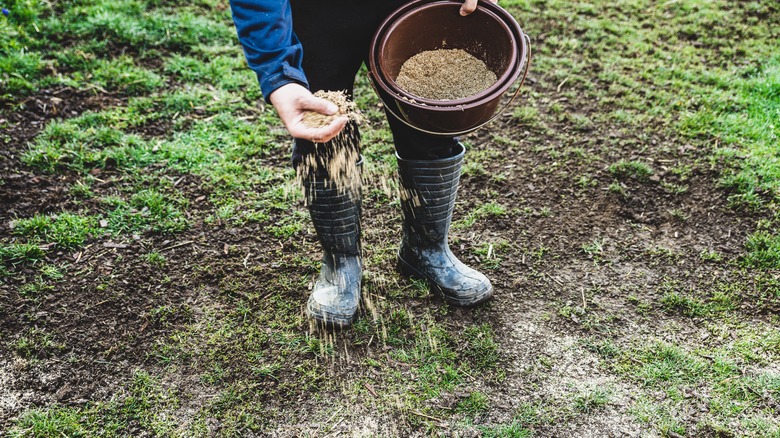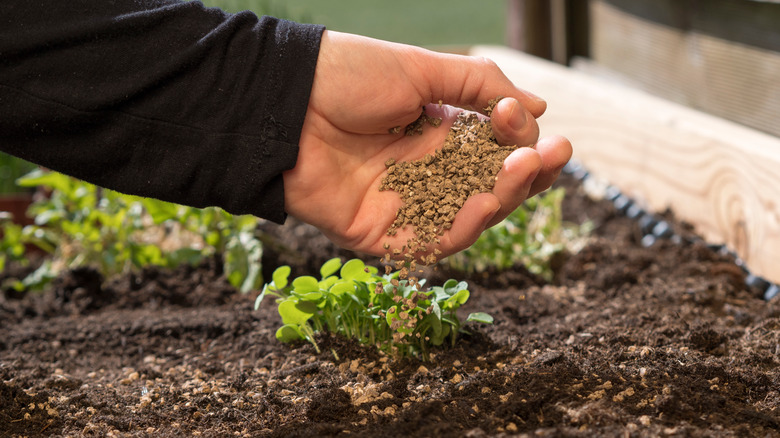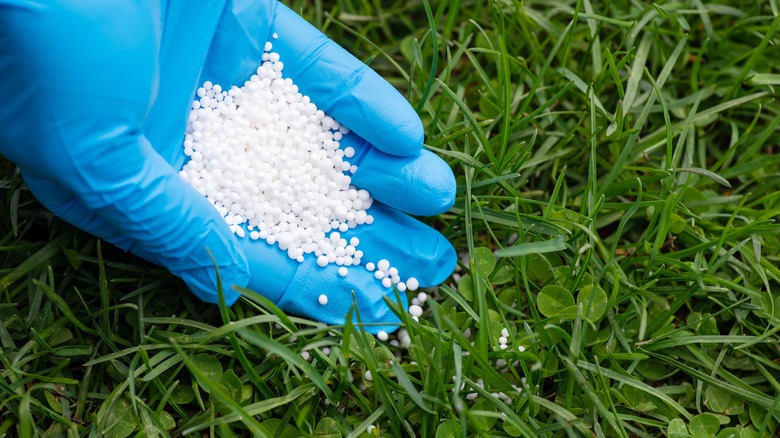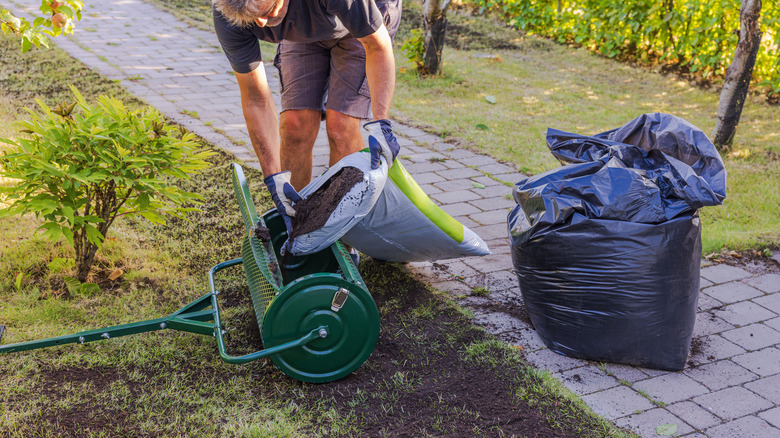The Best Fertilizers To Use When Overseeding Your Backyard (& Which To Avoid)
Fall is here, which means gardeners with cool-season grasses are getting ready to overseed their lawns. Overseeding in late summer or early fall is a great way to fill in a thinning lawn for a denser turf next season. Since a thinning or patchy lawn is usually a sign that your grass isn't getting everything it needs, it's important to make sure you're addressing the underlying problems in your soil rather than just adding new seed. If you forget this crucial step before overseeding your lawn this fall, your new grass will likely suffer the same fate as your existing grass. For many gardeners, the solution is to use a fertilizer.
When overseeding a lawn, your new seed might benefit from a phosphorus-rich starter fertilizer to promote strong root growth. Just be sure to opt for an organic formula rather than a synthetic fertilizer. If not used carefully, synthetic fertilizers can come with several risks. They provide a quick shot of certain key nutrients, but they are used up or washed away quickly so often you may need to reapply them multiple times. They also won't do anything to improve your soil, which means you'll likely find yourself overseeding your lawn all over again next fall. Instead, use an organic fertilizer as a short-term fix while also correcting any drainage, compaction, or nutrition issues in your soil over the long term.
Use a phosphorus-rich organic fertilizer
When overseeding your lawn, the best choice is an organic fertilizer that's high in phosphorus. Sometimes referred to as starter fertilizers, these phosphorus-rich formulas are meant to promote early root growth, helping your new seedlings get established quickly and develop strong root systems. Organic fertilizers are made from ingredients like manure, bone meal, or minerals that naturally contain high concentrations of the nutrients plants need. For a phosphorus-rich formula, look for one made from bone meal or rock phosphate. Depending on what you get, organic fertilizers will release nutrients over a period of a few weeks to months. So your new seedlings will get a steady supply of nutrients throughout their early growth phase.
Before applying fertilizer or any other soil amendment, test your soil first. A soil test will show you exactly what nutrients are missing so you can pick an organic fertilizer that will correct the deficiencies in your lawn. If there's already plenty of phosphorus in your soil, buying an organic fertilizer that your soil doesn't actually need would be a waste of money. In a decades-long research project coordinated by the Nebraska On-Farm Research Network, researchers found that applying a phosphorus-rich fertilizer did not improve crop yields unless the soil it was applied to had previously tested low for phosphorus. While the research focused on corn and other cash crops, it's likely that the same would apply to your lawn.
Why you should avoid synthetic starter fertilizers
As you research your fertilizer options for your lawn, you'll likely come across a lot of starter fertilizers that are made from synthetic ingredients. While they can deliver similar results as organic fertilizers in the short term, they come with a few issues. For one, these synthetic formulas rarely contain a complete nutrient profile. While nitrogen, phosphorus, and potassium are the big three ingredients most plants need, there are also tons of micronutrients that are important. Relying solely on synthetic fertilizer won't provide the complete, balanced nutrition your lawn needs to stay healthy all season long.
Another issue is that these fertilizers are typically highly soluble and break down quickly. Their fast-release design is what helps them create such quick results, but it also comes with two big tradeoffs. First, if your seedlings absorb too much of those nutrients, it can end up causing damage, sometimes called nutrient burn. Another risk is that the fertilizer will leach away in the rain or as you water your lawn, causing most of it to run off before your newly seeded lawn has a chance to take up what it needs. Plus, it can harm the environment. If you are going to use a fast-release option like synthetic fertilizer, it's important to get your soil tested first to make sure you're choosing formula that actually addresses the nutritional gaps in your soil.
Consider compost for long-term lawn health
Fertilizer can be beneficial when overseeding, but it's also helpful to explore other materials you can use to top-dress your lawn. Long-term soil health will make your lawn less dependent on fertilizers, and compost is one of the best options for this. It contains a complete nutrition profile in a slow-release form that won't cause nutrient burn and will feed your lawn all season long. Good compost can also serve as a soil conditioner, improving soil structure and helping with moisture retention. Keeping the soil consistently moist, but not waterlogged, is critical during the germination period. While fertilizers get used up or washed away, each application of compost helps build a nutrient-dense soil foundation with better moisture retention and aeration.
You can also safely combine compost with fertilizer if desired. The fertilizer can serve as a short-term supplement to fill the nutritional gaps in your soil, while the compost works to improve the overall quality of your soil in the long-term so you don't have to keep relying on fertilizer. If you have tricky spots in your lawn, like dry, compacted soil in some areas or poor drainage in others, compost can help correct both of those conditions, and it's easy to enrich your lawn with compost ingredients you likely already have at home. Those improved soil conditions, in turn, promote a denser, greener turf with a strong root system. With that healthier lawn, you can end up having fewer patches or thin spots that need to be overseeded in the future.



